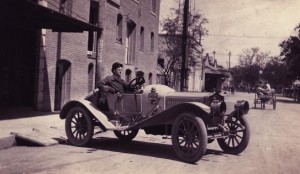100th anniversary of San Antonio’s first traffic laws

Lewis bzirdsong in a 1910 Franklin on College Street, San Antonio
It is, of course, one of the more minor centennial occasions. You probably won’t celebrate it but you will, without noticing, except for this little reminder, observe it. February 7, 2010 is the 100th anniversary of San Antonio’s first traffic ordinance. Nine years after the first gasoline powered horseless carriage, eight years after the city gained its first automobile agency, seven after the creation of the San Antonio Automobile Club, and six years after the city mandated that all vehicles be registered and display ID plates or numbers, the city introduced written rules for all road users.
Comprised of three sections containing thirty-one rules in all, number one is the most significant today. “Vehicles going in opposite directions shall pass each other on the right.” This answers a frequently asked puzzler: Who decided that folks would drive on the right side of the road? In essence, no one did. It certainly wasn’t a federal or state mandate. It was simply a custom that became codified by local authorities up and down the country. In all my research I have never heard of a locality in the USA that drove on the left. It has been suggested that the British preferred the left because most held their swords in their right hand so passing on the left meant you were better protected. In the USA, it was easier for stage coach operators to shake hands and exchange mail if they passed to the right. At the end of the day, it seems just to be lost to the mists of time.
Before I move on, some folks credit Henry Ford who placed the driving position on the Model T introduced in 1908 to the left, in contrast to his own previous vehicles and those of almost all other American manufacturers. This was indeed one of the contributing factors to the car’s initial popularity. The very earliest horse carriages, the Curved Dash Oldsmobile, had a centrally placed tiller but the brake pedal was on the right. What is strange about this is while this was quite suitable for the British drove on the left side of the road; it ran against the grain in America where folks preferred to use the right hand side. Ford was simply the first to recognize this and reaped the benefits accordingly.
Rule number two, and you may be relieved to know I do not intend to enumerate them all, state that overtaking must be done on the left, so no inside passing even way back then. Vehicles could only be parked with their right side at the curb and no further than twelve inches from it. I could go on. And on. Instead I will suffice to comment only on those rules we no longer have to obey. At the time these rules were promulgated, most vehicles lacked either brake or direction indicators. Brake lights were not introduced until 1925 and did not become mandatory until much later . Turn indicators were first devised as early as 1907, were not introduced commercially until the mid 1930s and did not become a legal requirement until the 1940s. The 1910 traffic rules therefore instruct the driver regarding various hand or vocal signals.
The other major area concerns horse drawn traffic. All of the rules apply to all forms of transportation though the bicycle is not mentioned per se. It turns out that motorists were not obliged to stop their engines for all horse drawn traffic. They only had to come to a standstill if they were signaled to do so by a person riding a horse or driving a team that was agitated. They were then obliged to wait until they had been safely passed. As the speed limit within one mile of San Fernando cathedral was just eight miles an hour and fifteen otherwise within city limits, and all vehicles were forbidden to cross rive bridges at a speed higher than that of a walking horse, such delays were probably not too difficult to bear. Plus, spotting an opportunity, folks set themselves up in business, and advertised tin the local newspapers, to train horses to remain calm in the proximity of gasoline powered vehicles.
By the time revised traffic rules were published in 1921, just about all mention of horse drawn traffic was gone. In fact a person wishing to pass his or her driving test would probably be able to pass just from studying the small booklet. While Ford stuck stubbornly to the cumbersome, pedal activated, two speed planetary transmissions until 1927, the introduction of by now common three speed manual transmissions by its arch rival Chevrolet in 1916 brought about a standardization of vehicle operations that would allow just about anyone who can drive a stick shift car would be quite familiar with most cars other than Model Ts from this era. Of course this number itself is dwindling due to the almost universal popularity of automatics. Refinements continue, of course, but, largely speaking, the 1910 road rules still apply.